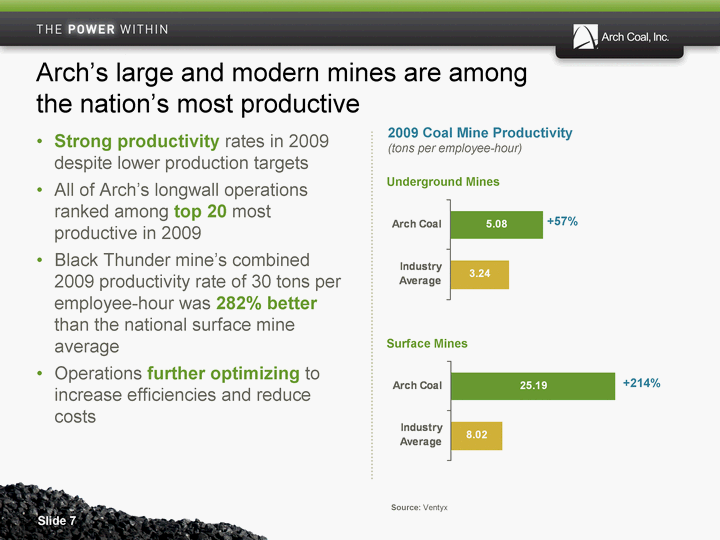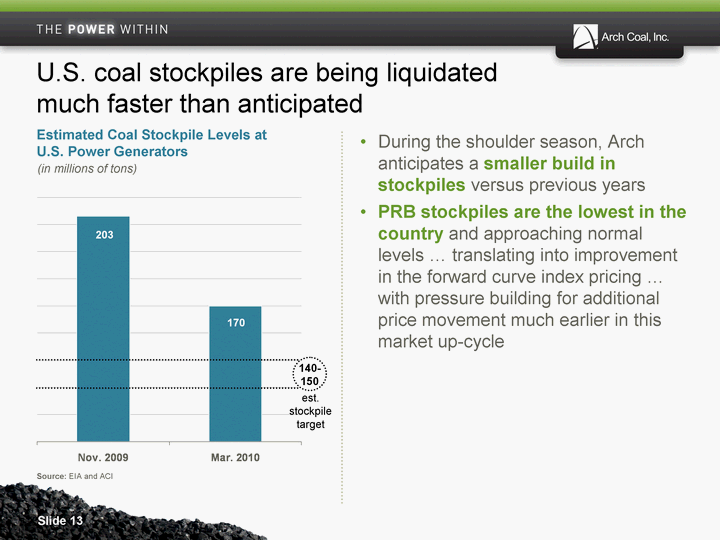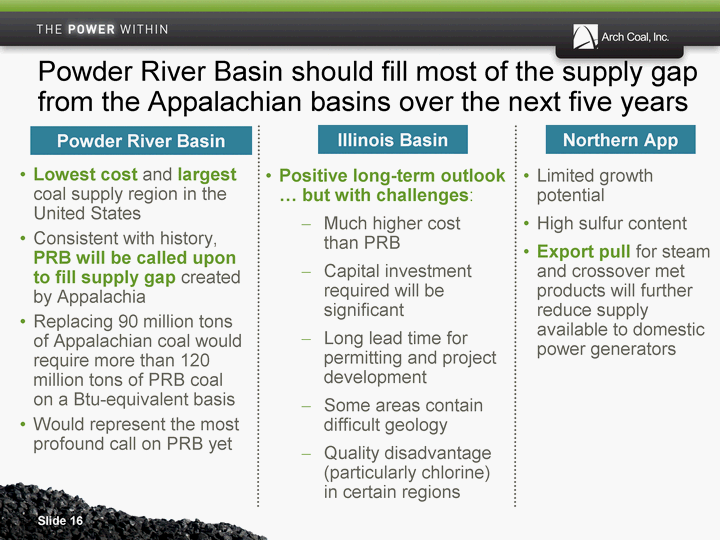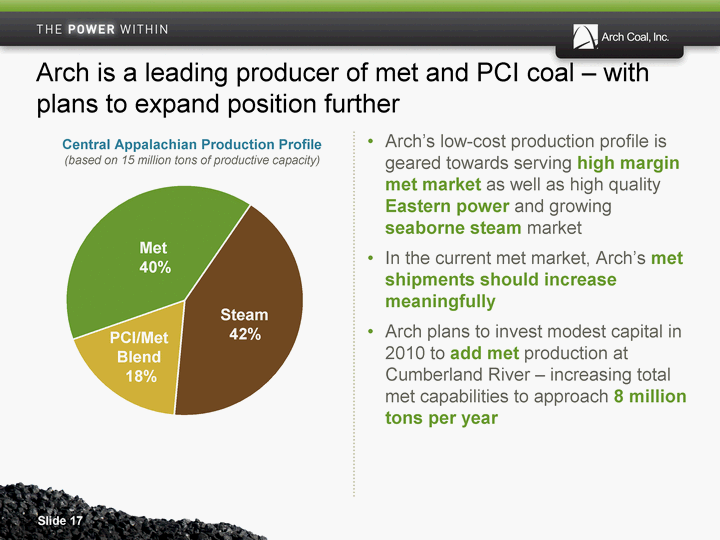Attached files
| file | filename |
|---|---|
| 8-K - FORM 8-K - ARCH RESOURCES, INC. | c57672e8vk.htm |
Exhibit 99.1

| Annual Shareholder Meeting STEVEN F. LEER Chairman and CEO, Arch Coal, Inc. St. Louis | 04.22.2010 |

| This presentation contains "forward-looking statements" - that is, statements related to future, not past, events. In this context, forward-looking statements often address our expected future business and financial performance, and often contain words such as "expects," "anticipates," "intends," "plans," "believes," "seeks," or "will." Forward- looking statements by their nature address matters that are, to different degrees, uncertain. For us, particular uncertainties arise from changes in the demand for our coal by the domestic electric generation industry; from legislation and regulations relating to the Clean Air Act and other environmental initiatives; from operational, geological, permit, labor and weather-related factors; from fluctuations in the amount of cash we generate from operations; from future integration of acquired businesses; and from numerous other matters of national, regional and global scale, including those of a political, economic, business, competitive or regulatory nature. These uncertainties may cause our actual future results to be materially different than those expressed in our forward- looking statements. We do not undertake to update our forward-looking statements, whether as a result of new information, future events or otherwise, except as may be required by law. For a description of some of the risks and uncertainties that may affect our future results, you should see the risk factors described from time to time in the reports we file with the Securities and Exchange Commission. This presentation includes certain non-GAAP financial measures, including Adjusted EBITDA. These non-GAAP financial measures are not measures of financial performance in accordance with generally accepted accounting principles and may exclude items that are significant in understanding and assessing our financial results. Therefore, these measures should not be considered in isolation or as an alternative to net income from operations, cash flows from operations, earnings per fully-diluted share or other measures of profitability, liquidity or performance under generally accepted accounting principles. You should be aware that our presentation of these measures may not be comparable to similarly-titled measures used by other companies. A reconciliation of these financial measures to the most comparable measures presented in accordance with generally accepted accounting principles has been included at the end of this presentation. Forward-Looking Information |

| Slide 3 Today Arch Coal is bigger and better than ever Second largest coal producer in the U.S. Leading U.S. position in all three major low-sulfur coal basins Significant exposure to metallurgical markets Diversified reserve portfolio of 4.7 billion tons Represent 16 percent of the U.S. coal supply Provide cleaner-burning, low-sulfur coal to 183 domestic power plants in 39 states to fuel 8 percent of the nation's electricity Ship coal to domestic/international steel manufacturers and international power producers Lead coal industry in mine safety and environmental compliance Talented workforce operates large, modern mines |

| 1st Qtr 2nd Qtr 3rd Qtr East 5 10 90 1st Qtr 2nd Qtr 3rd Qtr East 15 5 90 1st Qtr East 20.4 Arch's national scope of operations and reserve base includes presence in five major U.S. coal basins 1st Qtr 2nd Qtr 3rd Qtr East 30 30 30 1st Qtr East 20.4 Western Bituminous 1. West Elk 2. Skyline 3. Dugout 4. Sufco 5. Arch of Wyoming Powder River Basin 1. Black Thunder 2. Coal Creek 3. Otter Creek reserves Headquarters Illinois Basin 1. Knight Hawk equity interest Central Appalachia 1. Mountain Laurel 2. Coal-Mac 3. Cumberland River 4. Lone Mountain 4.7-Billion-Ton Reserve Base* *Pro-forma reserves at 12/31/09 including Montana state lease CAPP (336 Million) NPRB* (1,500 Million) ILB (374 Million) SPRB (2,053 Million) WBIT (455 Million) Compliance Low Sulfur High Sulfur 1 2 5 2 3 4 1 4 3 1 2 3 1 |

| Slide 5 a Arch Coal 11 Alpha 16.2 Patriot 18.4 Massey 37.1 a Chevron 4.5 Oxbow 5.7 Peabody 7.8 Pacificorp 9.4 Arch Coal 17.3 Arch is a top producer in each of nation's key low-sulfur coal-producing basins Western Bituminous Powder River Basin Central Appalachia (1) Includes roughly 10 million tons of brokered coal from Jacobs Ranch Source: ACI, Ventyx, SEC filings Peabody Arch Coal (pro forma) Cloud Peak Alpha (pro forma) Consol Massey Patriot Alliance ICG James River Production 244 126.1 103.3 86 58.1 36.7 32.8 25 16.8 9.6 29 Arch Coal stand-alone Jacobs Ranch a Alpha 49.15 Cloud Peak 94 Arch Coal 77.7 42.1 Peabody 137.4 137 120 93 50 2009 Tons Sold (in millions of tons) 2009 Tons Produced (in millions of tons, excludes brokerage) |

| In 2009, we set new records and made further progress toward our company vision Record safety lost-time and total incident rates 10 subsidiary mines and facilities achieved zero lost-time incidents Four operations completed three-plus years without a lost-time injury Earned 12 national and state awards for safety excellence Record environmental compliance Received 11 total SMCRA violations - a 22% improvement over 2008 "In the black" financial performance Despite recession, ACI recorded a profit in 2009 Focused on cost-containment and optimization Maintained one of the industry's strongest, cleanest balance sheets 2005 2006 2007 2008 2009 1Q10 Industry 3.49 3.37 3.31 2.97 2.93 3 Arch Coal 0.88 1.23 1.02 0.81 0.71 0.34 Sources: ACI, MSHA, State environmental agencies Lost-Time Safety Incident Rate (per 200,000 employee-hours worked) Arch five-year average = 0.93 Industry five-year average = 3.21 2005 2006 2007 2008 2009 Peers 119 133 91 98 75 Arch Coal 37 18 14 14 11 Environmental Compliance (SMCRA violations based on state reports) Arch five-year average = 22 Peer five-year average = 103 |

| Arch's large and modern mines are among the nation's most productive Strong productivity rates in 2009 despite lower production targets All of Arch's longwall operations ranked among top 20 most productive in 2009 Black Thunder mine's combined 2009 productivity rate of 30 tons per employee-hour was 282% better than the national surface mine average Operations further optimizing to increase efficiencies and reduce costs Source: Ventyx 2009 Coal Mine Productivity (tons per employee-hour) a Industry Average 3.24 Arch Coal 5.08 Surface Mines Underground Mines a Industry Average 8.02 Arch Coal 25.19 +214% +57% |

| Expanded presence in expansive Powder River Basin provides future organic growth opportunities Arch recently completed strategic investments in Wyoming and Montana Black Thunder integration of former Jacobs Ranch mine Secured Otter Creek coal reserves from GNP and state of Montana The assets acquired are located in the Northern and Southern PRB, which represent the lowest cost and largest coal supply regions in the United States PRB coal continues to expand market share east of Mississippi River PRB will help fill supply gap created by Appalachia Growing interest in expanding PRB exports off the west coast Black Thunder Otter Creek Source: ACI and Ventyx |

| Arch expects to generate stronger earnings in 2010 2006 2007 2008 2009* 2010 Midpoint* 1.8 1.21 2.45 0.42 1.2 We recorded a 2009 profit despite the global recession and a rapid 11% decrease in U.S. coal demand Arch continues to execute a market- driven approach, leaving coal in the ground and focusing on business efficiency, cost-containment Capital expenditures in 1Q10 were the lowest level in six years In 2010, we expect to generate stronger earnings per share and EBITDA thanks to improving coal markets First quarter revenues grew 4.5 percent in 1Q10 versus 1Q09, while cash flow from operations increased 63 percent Earnings Per Share (per diluted share) Adjusted EBITDA (in $ millions) 2006 2007 2008 2009 2010 Midpoint* EBITDA 545 471.7 753.2 458.7 745 Source: ACI 2010 midpoint estimates at 4/19/10 *Excluding acquisition charges and sales contract amortization *Adjusted EPS and EBITDA is defined and reconciled at end of presentation |

| Despite scrutiny of fossil fuels, we believe policy makers increasingly recognize coal's essential role While prospects for comprehensive climate legislation in 2010 have dimmed, there is strong and growing support for clean coal technologies The ACES bill that passed the House would have provided up to $200 billion for CCS Senators Rockefeller and Voinovich are currently pursuing a stand-alone bill with significant CCS funding Prospects are better for an "energy only" bill that seeks to boost energy efficiency while providing support for renewables and CCS Meanwhile, EPA is taking steps to regulate greenhouse gases and further restrict other emissions from power plants Despite challenges, we expect coal will maintain its position as the primary source of electricity generation in the U.S. for decades to come |

| Slide 11 Global coal supply flows continue to shift - and create further opportunities for U.S. met/steam coal exports USA: potential growing seaborne supplier with available export capacity; emerging supplier to Pacific Rim South America: infrastructure constraints; political instability; growing regional coal burn; emerging supplier to Pacific Rim Russia: coal exports to Asia are increasing, while coal exports to Europe are decreasing Europe: coal production declining; growing coal burn in eastern Europe; traditional import supply waning South Africa: 30% of coal exports moved to India in 2009; domestic needs and infrastructure constraints limit export growth Who will supply coal in Atlantic Basin during the next market up-cycle? Increasing Decreasing Moderating Atlantic Basin Market ~ 36% of Global Seaborne Trade in 2009 |

| Coal was disproportionately impacted by downturn in 2009; should outperform other fuels in recovery Incremental U.S. Coal Consumption and Supply (in millions of tons) Source: EIA 2009 2010E Economy 55 - 65 20 - 25 Weather 25 - 35 25 - 30 Natural Gas 20 - 30 15 - 20 Hydro 3 - 5 1 - 2 Nuclear 1 - 3 0 - 2 Total Demand 120 60 - 80 Supply 97 0 - 20 Surplus/Deficit 23 ~80 |

| Slide 13 Nov. 2009 Dec. 09 Jan. 10 Feb. 10 Mar. 2010 stockpiles 203 190 176 165 170 Estimated Coal Stockpile Levels at U.S. Power Generators (in millions of tons) Source: EIA and ACI est. stockpile target U.S. coal stockpiles are being liquidated much faster than anticipated During the shoulder season, Arch anticipates a smaller build in stockpiles versus previous years PRB stockpiles are the lowest in the country and approaching normal levels ... translating into improvement in the forward curve index pricing ... with pressure building for additional price movement much earlier in this market up-cycle 140- 150 |

| Slide 14 '97 '98 '99 '00 '01 '02 '03 '04 '05 '06 '07 '08 '09 '10E OECD 290 278 265 264 271 249 231 232 236 236 227 235 197 170 U.S. coal production continues to shift westward as Central Appalachia is in long-term decline Sharp price run-ups have acted to arrest production declines only temporarily Based on historical trend, most of that supply reduction is likely to be permanent The 2008 - 2010 drop is shaping up to be the largest decline in production yet Source: Coal Daily Price Indices (CAPP 12,000 Btu / 1% Sulfur / CSX) and Ventyx Supply +3% Supply +2% Price +150% Price +120% Price +270% Supply +4% million ton decline 70 Production in Central Appalachia (in millions of tons) |

| Competition is set to increase for constrained coal supply in Northern and Central Appalachia Nearly 90 million tons of high-Btu Appalachian production could disappear from steam coal markets or migrate to higher margin met coal markets Other coal basins will need to fill the supply gap left by the Appalachia basin Northern and Central Appalachia Coal Production (in millions of tons) 2008 2010E Jan. 10 Feb. 10 1 Steam/Industrial 311 225 184 175 140 Industrial 30 15 Met 61 70 Crossover 10 15 372 295 61 311 225 70 Steam/Industrial Met/PCI/Met Blend Source: EIA and ACI |

| Lowest cost and largest coal supply region in the United States Consistent with history, PRB will be called upon to fill supply gap created by Appalachia Replacing 90 million tons of Appalachian coal would require more than 120 million tons of PRB coal on a Btu-equivalent basis Would represent the most profound call on PRB yet Powder River Basin Powder River Basin should fill most of the supply gap from the Appalachian basins over the next five years Illinois Basin Positive long-term outlook ... but with challenges: Much higher cost than PRB Capital investment required will be significant Long lead time for permitting and project development Some areas contain difficult geology Quality disadvantage (particularly chlorine) in certain regions Northern App Limited growth potential High sulfur content Export pull for steam and crossover met products will further reduce supply available to domestic power generators |

| Arch is a leading producer of met and PCI coal - with plans to expand position further PCI/Met Blend Met Steam 0.18 0.4 0.42 Central Appalachian Production Profile (based on 15 million tons of productive capacity) Met 40% PCI/Met Blend 18% Steam 42% Arch's low-cost production profile is geared towards serving high margin met market as well as high quality Eastern power and growing seaborne steam market In the current met market, Arch's met shipments should increase meaningfully Arch plans to invest modest capital in 2010 to add met production at Cumberland River - increasing total met capabilities to approach 8 million tons per year |

| Arch Unpriced Tonnage (as of 3/31/10, in millions of tons) 2009 2010 2011 2012 Committed and Priced 100 Committed, Not Yet Priced 9 13 20 20 Uncommitted 0 0 75 105 Arch employs a pragmatic, market- driven pricing strategy We remain committed to maintaining near-term stability in earnings Effectively sold out for 2010; retain some price exposure We also strive to preserve our long- term earnings leverage by retaining the flexibility to layer in future volumes at attractive levels 70 20 105 Committed, Not Yet Priced Uncommitted Arch is strongly positioned for the recovering domestic coal market 20 10 |

| 2009 2010 2011 2012 2013 2014 2015 2016 2017 2018 2019 Debt 44 63 91 0 90 0 0 0 Notes 3 950 600 Debt Maturity Profile (at 3/31/10, in $ millions) Source: ACI and peer SEC filings Arch maintains one of the strongest and cleanest balance sheets in the U.S. coal industry Peer 1 Peer 2 Competitor #3 Peer 3 Peer 4 ACI pension 192 215 96 56 69 reclamation 533 452 116 206 235 310.4 postretirement medical 2844 982 487.9 710 162 46 workers comp 375 9 35 44 115 37 CNX BTU Peer 3 ANR MEE Legacy Liabilities of Largest U.S. Coal Companies (at 12/31/09, in $ millions) $3,944 $1,056 $1,658 $567 $462 Peer 1 Peer 2 Peer 3 Peer 4 ACI $91 $600 Financing initiatives in 2009 enhanced liquidity and extended debt maturities Available liquidity is more than $700 million Low level of legacy liabilities vs. peers Two-thirds of Arch's legacy liabilities are comprised of reclamation liabilities $63 Revolver/other short-term debt Unsecured notes Workers' Comp Post-Retirement Medical Reclamation Pension $90 $950 $0 $0 $0 |

| With major expansion plans completed, Arch is focused on generating free cash flow *Adjusted EBITDA is defined and reconciled at end of presentation From 2004-2007, Arch completed a large capital spending program that supported organic growth initiatives Looking ahead, Arch will maintain rigorous capital and cost control - with a focus on growing free cash flow in 2010 and beyond Arch will evaluate all priorities for utilizing free cash flow, including: Debt pay down Dividends Share repurchase Re-investing in the business through organic growth and acquisition opportunities Investments to expand market for coal (coal conversion technologies) Arch Coal, Inc. (in $ millions) 2005 2006 2007 2008 2009 2010E Adj. EBITDA 290.6 545 471.7 753.2 458.7 Capital Expenditures 9 623.187 488.4 497.3 323.2 Uncommitted 0 6.5 75 105 Adj. EBITDA* Capital spending including reserves, before acquisitions |

| We carefully align our business goals with our core values Safe Responsible Growing Strengthening top safety record by sharing best practices inside and out Investing $14 million for underground communication and tracking systems Providing solutions to help address growing demand for energy worldwide Investing in technology leaders to identify cleaner ways to use coal, such as Trailblazer Energy Center and ADA-ES Serving growing domestic and global markets: 21 countries served since 2008 Generating estimated '10 EBITDA of between $700 million and $790 million |

| Non-GAAP Measures Reconciliation Chart Included in the accompanying presentation, we have presented Adjusted Earnings Per Share and Adjusted EBITDA, which are are considered non-GAAP measures as defined by Regulation G. The following reconciles these items to net income as reported under GAAP. Adjusted diluted earnings per common share is adjusted for the after-tax impact of acquisition-related expenses and is not a measure of financial performance in accordance with generally accepted accounting principles. Adjustments made to arrive at these amounts are significant in understanding and assessing our financial condition. Therefore, adjusted diluted earnings per share should not be considered in isolation nor as an alternative to diluted earnings per common share under generally accepted accounting principles. We believe that adjusted diluted earnings per common share better reflects the trend of future results. Adjusted EBITDA is defined as net income before the effect of net interest expense; income taxes; our depreciation, depletion and amortization; epenses resulting from early extinguishment of debt; and other non-operating expenses. Adjusted EBITDA is not a measure of financial performance in accordance with generally accepted accounting principles, and items excluded to calculate Adjusted EBITDA are significant in understanding and assessing our financial condition. Therefore, Adjusted EBITDA should not be considered in isolation nor as an alternative to net income, income from operations, cash flows from operations or as a measure of our profitability, liquidity or performance under generally accepted accounting principles. We believe that Adjusted EBITDA presents a useful measure of our ability to service and incur debt based on ongoing operations. Furthermore, analogous measures are used by industry analysts to evaluate operating performance. Investors should be aware that our presentation of Adjusted EBITDA may not be comparable to similarly titled measures used by other companies. The table below shows how we calculate Adjusted EBITDA. |
